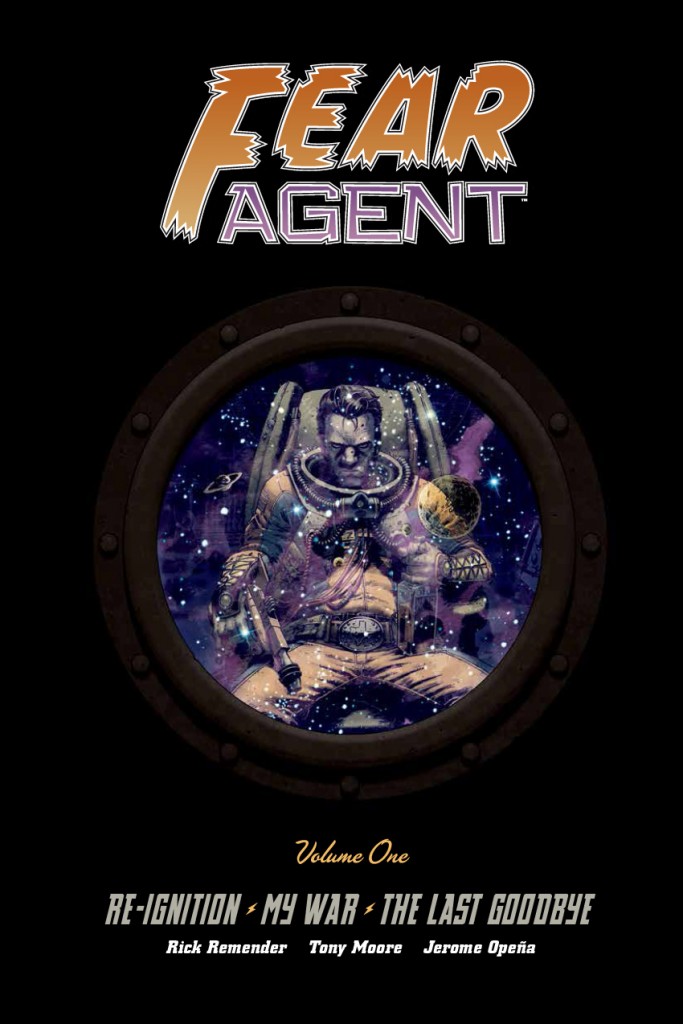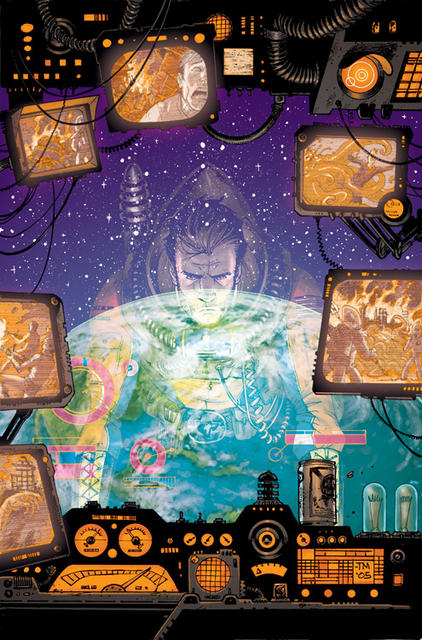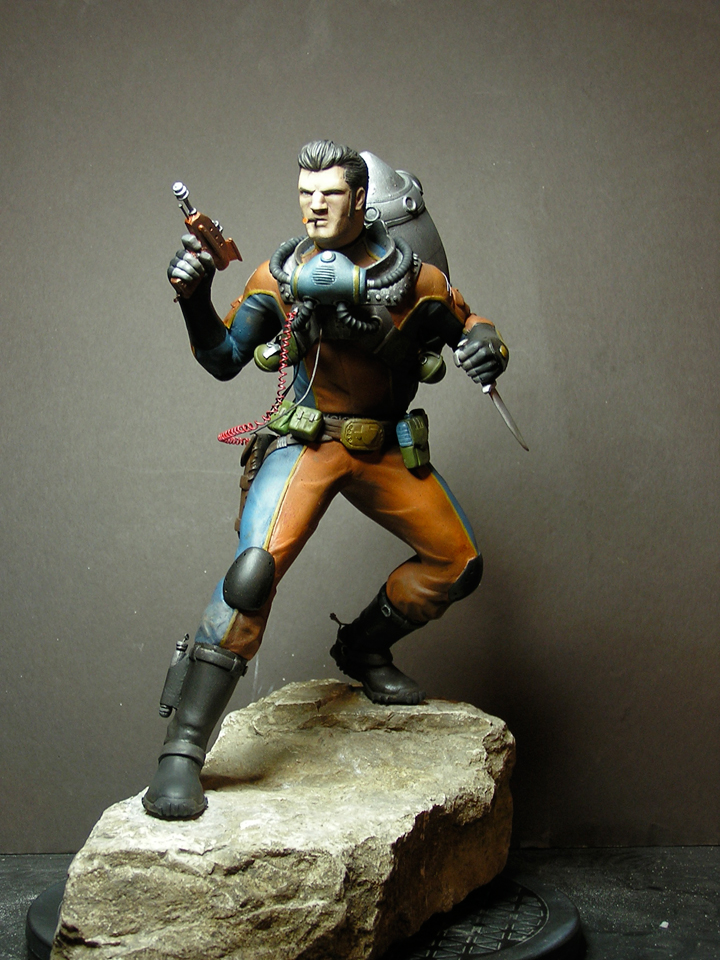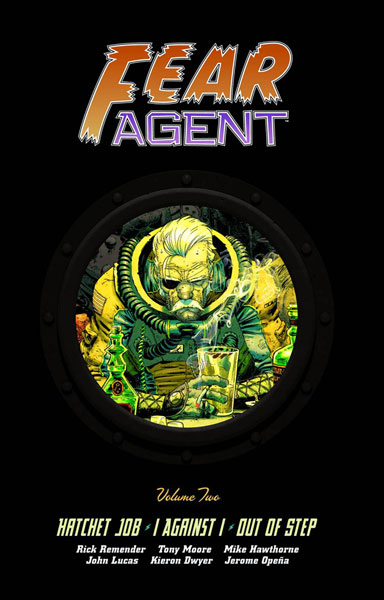
Turn back the clock back to the evening on a night in June 2007 in a hotel room in Charlotte, North Carolina. That was the first time I ever read Fear Agent. Conor, Josh and I were attending Heroes Con and Conor had picked up the first two trade paperbacks. Josh was reading volume 1, so I grabbed volume 2 to see what it was about. About 15 minutes later, I turned to Josh and said something along the lines of, “Holy shit, this is fantastic!” Josh heartily agreed and thus began the reign of one of the few titles so universally appreciated and loved by iFanboy.
 Today, almost 6 years later, the Fear Agent Omnibus, Vol. 1 has finally been released by Dark Horse. After wrapping up the series a year ago, I was curious what the series creators, writer Rick Remender and artists Tony Moore and Jerome Opeña, felt about the entire experience. I caught up with them a few weeks back we had a very long conversation, going back to the origins of the title, the ups and downs of the run and ultimately what it’s like to be here today, with the series wrapped and collected in a high end archival edition. What you’re about to read is the first part of three of the Oral History of Fear Agent, my little addition to the legacy of one of the finest creator owned comics of this century.
Today, almost 6 years later, the Fear Agent Omnibus, Vol. 1 has finally been released by Dark Horse. After wrapping up the series a year ago, I was curious what the series creators, writer Rick Remender and artists Tony Moore and Jerome Opeña, felt about the entire experience. I caught up with them a few weeks back we had a very long conversation, going back to the origins of the title, the ups and downs of the run and ultimately what it’s like to be here today, with the series wrapped and collected in a high end archival edition. What you’re about to read is the first part of three of the Oral History of Fear Agent, my little addition to the legacy of one of the finest creator owned comics of this century.
On Wednesday, hours after the first part of this oral history went live, Dark Horse comics announced that the Fear Agent Library Edition, Volume 1 had sold out at every level. But fear not if you missed out, a second printing was also announced, shipping in April along with volume 2! So get your orders in now while you can!
Fan Reactions
With Fear Agent spanning over 6 years, the fanbase for it grew to a dedicated and loyal lot.
Remender: There have been lots and lots of people with tattoos. There’ll be people at shows that have made entire Heath Huston costumes. There have been a couple people who have made Fear Agent sculptures that are like better than…I mean they’re just insane, how wonderful they are. You cannot believe that somebody put that much
time and love into it. There was a video game–he made it with the Unreal engine and you can play Heath and run around and shoot feeder aliens and checkout the space station from issue two.
Moore: There was a really great cosplayer that I met in Toronto who had a really decked out Heath Huston costume. I couldn’t get over that. There’s an absolute killer sculpture of Heath with a feeder alien that he cast in clear resin and it really blew my mind. Bubble helmet, the cigar, every minute detail he locked it in. It was really killer.
Remender: That stuff brings me around full circle to something that Kieron Dwyer said once, that it always was a really great way to look at these things, his thing was “I don’t care about fame, I don’t need my name to matter. I don’t need anybody to know my name or to know me. I want something I created to be known.” I always remembered that moving forward because that really is the goal.
The goal is to just create something that makes it out there, something that you didn’t pander with and something that you made because you loved it and that other people respond to. That’s as good as it gets. I mean it makes all of those hours of labor and the fear of making something with no idea what the rewards will be, just the hard labor of creating the thing.
It makes it all worthwhile to know that there are people who loved it that much and that was always the thing that kept us going. While it might not have had huge numbers and it might not have been the thing that everybody was beating the drum about, you know there were people that were. And for the people who were–iFanboy being the website that I remember that always enjoyed it and made sure to talk it up and beat the drum. That’s been the real upshot of the whole experience, is the people who did care, really cared, and that’s more important than having a sea of people kind of care.
Moore: A lot of people that just kind of tolerate [comics]. We don’t really have that. We don’t have the audience of people who do, “Whatever, that’s cool.” Like we’ve got our hands full with super hardcore fans who love it and then you know the rest are either people who’re just not that into it or they haven’t heard about it yet.
That’s really exciting. I’ve got like a stack of drawings in my studio that people have given me at conventions where they’ve just like lovingly rendered full pinup style drawings and to me that’s the most exciting that someone read the book and was inspired by it to create something too and then show it to us and give that love back, it’s really a pretty amazing feeling.
On Working Together
Through working on Fear Agent, the creative team have been able to climb the ladder of comics by working together.
Opeña: For me, if not for Fear Agent and meeting Rick, I would’ve never gotten to work at Marvel and I wouldn’t be who I am today or at least where my career is today.
Remender: Without Jerome, Fear Agent would’ve been a four issue miniseries and it wouldn’t have been able to reach the numbers that it did and look as good as it did and I would definitely…I can’t imagine my career at this point without Tony and Jerome having belief in me especially in a time when I was an unproven commodity as a writer. I think that I definitely can’t imagine where I would be right now, looking back at my career, looking at what we’ve done together, looking at the proudest moments of my career, you know most of those highlights involve the names Jerome Opeña and Tony Moore. It was something that we kind of grew on the book together and we all kind of used each others shoulders.
Moore: I can say, like, Jerome’s pages coming in definitely were an inspiration for me to try to up my game too. I think we all really grew a lot together for sure.
Opeña: The same could be said for me. Rick would always show me something that Tony was doing and I was like, “Oh shit! Man that’s awesome!” I would, like Tony said, try to improve or at least try to be as good as whatever I saw Tony doing. It was just good to help me improve as an artist as well just because I was working not against but with Tony as someone to kind of measure myself to or up against.
 Remender: That was my favorite part, watching those guys outdo one another. From a writer’s point of view it’s a win-win and we were all inspired. I was still drawing at that time, but I was living vicariously through what these guys were doing and as I sort of transitioned more into writing, watching those guys continue to progress, it’s just a joy. So Tony does the first arc and then Jerome comes in and just every issue got better and better and it just started going crazy.
Remender: That was my favorite part, watching those guys outdo one another. From a writer’s point of view it’s a win-win and we were all inspired. I was still drawing at that time, but I was living vicariously through what these guys were doing and as I sort of transitioned more into writing, watching those guys continue to progress, it’s just a joy. So Tony does the first arc and then Jerome comes in and just every issue got better and better and it just started going crazy.
Jerome was a legend in the Bay Area. I remember his sketchbooks being passed around and some of the ideas even came out of his sketchbook. I think in the Hatchet Job story, Jerome had drawn something in his sketchbook that had I think, forgive me if I’m wrong, I think it was the Cobra Kai dude from Karate Kid riding a skeleton fish through the air. I remember calling him up and being like “What is that?” and he’s like “I don’t know, it’s the dude from Karate Kid riding on a fish skeleton or something.” I was like, “Well, that’s what we need more of.”
You really do feed off of the art and so we worked up that first sequence in Hatchet Job where there were these barbarians riding gold fish around this tropical planet and that’s an idea that I wouldn’t have come to by myself. That’s the kind of thing that you come to collaborating and building off the visuals.
When Jerome started turning in issue after issue on that second arc, it was wild to watch that stuff just get better, better, and better to where then when Tony came back on. Tony had turned up the juice another 40% to try and match it. When Jerome came back, it was even crazier. I mean the Hatchet Job trade is where Jerome just went fucking nuts and this stuff is all beautiful but that trade is where it just gets even crazier and so then the next arc, Tony comes back and he’s escalating his game even further.
That’s what you want. It’s not competition, it’s just being inspired by your collaborators to do better and better work and I know that they really put me to the test as well to grow as a writer to live up to and earn putting my dumb words over such beautiful pages.
Bring Us The Library Edition
With Fear Agent coming to a close, fans began to clamor at the chance to get a collected edition of the whole epic.
Remender: The unfortunate reality is most things come down to the numbers and as our profiles have rising, the demand for the trades did as well. When [Uncanny] X-Force blew up, the second trade of Fear Agent sold out in like a week. All of the available copies were gone. Then at the same time, when Tony and I were doing The Punisher: Franken-Castle and then especially on Venom there was a big spike.
It’s great that people will, once their made aware, if they like your work, they’ll go back and see what else what you’ve done. We have unquestionably benefited from the Marvel work in that it has put a spotlight on us and made people curious about what we did before. That was trade build. It went from a financial question to “Oh well this will be fine” and it has been.
The numbers are really, really strong and that feels great. You don’t want to put everything on numbers but the unfortunate reality is, is that you need numbers in order to make the thing continue to exist. Seeing the numbers finally come back and this is something that we kept the price at $49.99. It’s basically the same as if you bought the three trades, but you’re also getting half of the first tale of Fear Agent trade and you’re getting I think like 30 pages of Jerome Opena and 20 more sketchbook stuff as well as layouts and cover sketches and stuff like that.
Finally all these years later, the trades have all gone into four, or five, or six printings, and the trades have been steadily selling where we’ll go through a print run every eight months to ten months which is nice. It’s nice that we’ve that in print and there is enough demand for it but the fact that there is also now enough demand for it to do one of these special over-sized library editions that Dark Horse does, against going full circle to what Tony was saying about Hellboy–the Hellboy Library Edition–that was always my dream.
When you held one of those, it was to do something important enough or beautiful enough that it warranted being in that format. I think that what you see with Tony and Jerome in that first volume and the second, which is even better, the first one’s great but then both those guys took an entire jump to a crazy new level and the second volume, the quality of it, it warrants that format and we’re really glad that you know we’ve been able to move things to a point where we can get one.
Moore: I was really taken aback to see that the numbers on the omnibus were topping the reorder charts because I didn’t expect it. I certainly didn’t expect it and I didn’t suspect it either so when I saw it I was really kind of touched. That we able to finally put all of our hard work together in these really handsome library edition format books and that the market was there for it that was like a really good retailer brand reaction to the idea too so that kind of warmed my heart after all these years of feeling like it was kind of an uphill battle.
Favorite Moment from the Fear Agent experience
Looking back on the experience, we were curious what the single moment for each of the creators was that defined the experience.
 Opeña: It was just really learning more about Heath as a character. That was really great because you know from the first issue he was just kind of this alcoholic, wisecracking asshole, but the more you read the comic and the more I was getting scripts from Rick, just learning about his back story and himself, just the character getting flushed out even more was really exciting, because to me, he’s like one of my favorite characters I’ve ever drawn in my short time in comics.
Opeña: It was just really learning more about Heath as a character. That was really great because you know from the first issue he was just kind of this alcoholic, wisecracking asshole, but the more you read the comic and the more I was getting scripts from Rick, just learning about his back story and himself, just the character getting flushed out even more was really exciting, because to me, he’s like one of my favorite characters I’ve ever drawn in my short time in comics.
He became this kind of sympathetic character after my initial feeling of him being like a Wolverine or Punisher type guy who’s not the nicest guy, but you know beneath that kind of exterior there’s really a sad story and I think that’s what I will always remember about working on this book.
Moore: I think probably as a personal proud moment that beginning of I Against I, there were first couple of issues of that, I really felt like I took all the time I needed on them,which was probably a nightmare for Rick and the editors because it kind of ate up all of our time pretty quickly. But once those issues were out, if I were to pick an issue that I thought wasn’t my pinnacle artistic issue of any book I’ve ever done, I would say Fear Agent #22, the first issue of I Against I is it. That’s the one that I felt like, it was done, when I felt like it was done it was everything I wanted it to look like and like I didn’t feel like I had any compromises in it at all.
Remender: That was also where [Lee] Loughridge went crazy on colors. He hit some new kind of science on that that was like licking a 9-volt battery. That issue was gorgeous. I hate to leave out Michelle Madsen. I don’t think we mentioned her but she colored all of Jerome’s stuff. I think that color can be overlooked but they were both also lending so much more than just coloring images and do things that a lot of people overlook. Yeah, that issue #22 was amazing and that was coming off of Jerome’s craziness. That whole era of the book is just one issue after another. This is an artistic masterwork.
For me, I think if you’re doing this right, you’re writing something personal into the stories. I know that when I was doing the book, I started doing comics, I think in 1998 when I started self publishing and then moved to Slave Labor Graphics and by 2004, 2005, 2006, while I had plenty of job offers with video game companies and animation studios, I had the comic book bug and I really wanted to do it. So I quit a lot of lucrative jobs that offered security for my family to continue to fight out this dream because I wanted to tell these stories and work with people like Tony and Jerome.
I think that as Heath starts off, as Jerome mentioned, he is sort of the stubble man of action, two-dimensional, joke making guy. When you start the underbelly of Heath and the damage, that stuff kind of grew out of where I was at in life at that point and fighting this stuff out and it’s such uphill battle. You know especially given that we were doing EC inspired pulp science fiction and there was no market for it. It was just going to be this uphill battle and that really started to bleed into Heath and I was moving around a lot myself at the time. I had moved from Oakland to San Francisco to Pacifica to Portland, and now I’m south of Los Angeles, and that was all during the course of production, so the idea of this depressive drifting aimlessly in space there were definitely some metaphors there for what I was dealing with and a lot of more somber broken down moments with Heath were written when I was pretty broken down myself and that was a great outlet.
It was a great place to explore that stuff. It was a great place to use Heath as a voice for some things that had happened to me and some stories that I had, so I’d say that my greatest memory looking back was having been able to sort of document that stuff and have a place, an outlet, to vocalize some of the frustrations and the depression that was growing from the rough few years of my life that I was going through at that point and Heath, sort of becomes a part of you at that point. He transcended the stubbled man of action and became a character who I think we all felt something for.
Moore: It was one of those kind of feelings where it kind of felt like the deck was stacked against us actually pulling it off for a long time and I know Rick really put a lot of effort into keeping this thing afloat and really just killed himself to make sure that things happened and you know we all put as much skin in it as we could and at the end, here, now it really kind of feels like the universe didn’t want it to happen and we were just screaming back, like, “Fuck you universe, here it is and it’s done!” It’s a pretty nice feeling to have actually pulled it off.
Like Fear Agent, all good things must come to an end, and so ends the Oral History of Fear Agent. Everyone at iFanboy would like to thank Rick Remender, Tony Moore and Jerome Opeña not only for their time in doing this oral history, but for giving us some of our favorite comics of the decade. It may be over, but Fear Agent will live on in our hearts.
Don’t miss out on the Library Editions! Order volume 1 while you can and get your pre-orders in for volume 2!




I am literally giddy with anticipation awaiting the first Library edition
Just got the email letting me know that mine has shipped!
Really cool how Tony remembered me from Toronto, Thanks man!